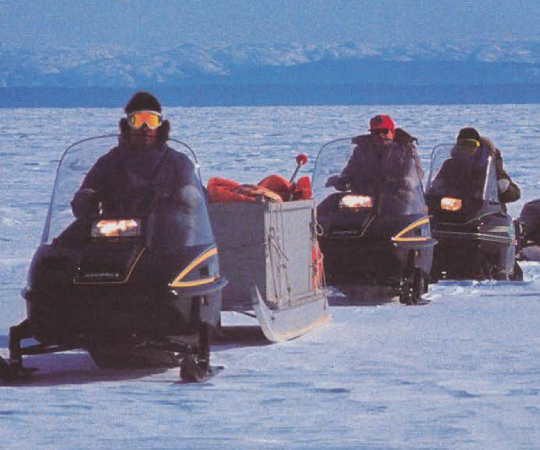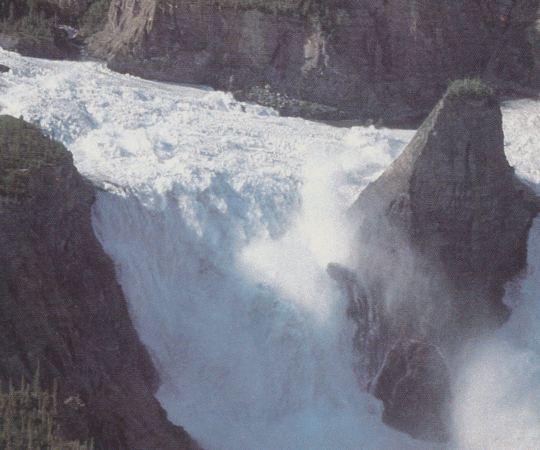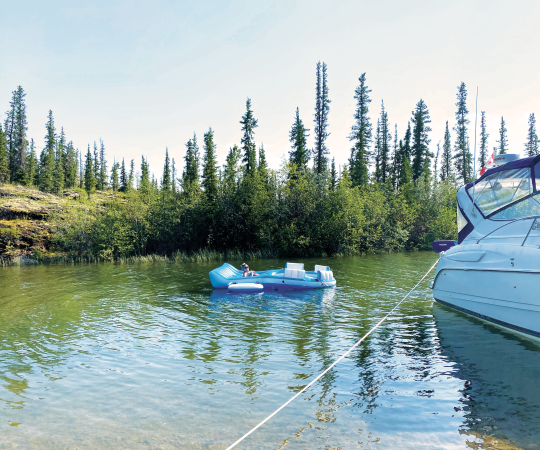It’s just before dinnertime on a sunny August evening when Canadian astronaut Roberta Bondar stands ready for her latest rocket launch into the unknown. Voices from mission control rhyme-off a final checklist: “Navigation?” “Go.” “Recovery?” “Go.” “Network?” “Go flight.” “Copy. You are go for launch.” KABOOM—a fiery trail of smoke rises off the horizon.
All eyes are up. A quadcopter drone hovers 200 feet in the air filming the moment, along with dozens of ground-based cameras. The rocket—a working model, barely a foot long and made out of a paper towel roll—streaks through the air above Fort Smith, NWT, with Bondar in attendance to open the area’s annual Dark Sky Festival. For the last week of August, close to 100 sky-gazers have started a yearly trek to the town and nearby Wood Buffalo National Park to take in astronomy lectures, planetarium shows, aurora, and some of the best views of the heavens the Northern Hemisphere has to offer.
Earlier that month, Fort Smith hosted paddlers from around the world for its Slave River Paddlefest—four sets of rapids churn a 25-kilometre-long, two-kilometre-wide section of the river near Fort Smith. There are hundreds of routes to meet any paddler’s skill level—from well-known beginner spots to seemingly impassable Class VI routes that have yet to be charted.
For a town with 2,500 people, Fort Smith is in the big leagues not only for paddling and
astronomy, but for wildlife viewing, wilderness camping and tourist amenities.
For centuries, what is now Fort Smith—originally known as Thebacha (“beside the rapids” in Chipewyan)—was the site of a well-established portage used by local First Nations to bypass the four sets of Slave River rapids nearby. By the late 1700s, early fur traders started to take advantage of the portage, and by the late 1800s, a Roman Catholic mission had been established with widespread commerce in the area dominated by the Hudson’s Bay Company, which built settlements and launched large steamboats to ferry goods through the area.
In 1874, the settlement at the most northern set of the rapids was named Fort Smith, in honour of Hudson’s Bay Company owner and Canadian Pacific Railway co-founder Donald Smith. Within 30 years, the addition of an RCMP detachment, a regional medical doctor and an agent from the Department of Indian Affairs had effectively made Fort Smith the transportation and administrative centre of the entire Western Arctic.
But that was nothing compared to the population boom of the first half of the 20th Century: the establishment of Wood Buffalo National Park, a new rail link, additional government offices, the discovery of oil in Norman Wells and gold near Yellowknife saw Fort Smith grow from a population of about 200 in the 1920s to more than 2,000 by the 1960s.
Then, in 1967, it looked like the party was over when a government commission found that residents of the NWT favoured moving the territory’s capital from Fort Smith to Yellowknife. It was a blow, but Smith, now home to 2,500, refused to fade. It now hosts the main campus of Aurora College, growing its team of Parks Canada interpreters and outreach staff, and turning the once-remote settlement into a surprisingly cosmopolitan town.
Out here, you can view subtle little filaments in the Milky Way you’d never see from the city
While traditional tourist draws like fishing have declined in recent years, photography, wildlife, and astronomy-based tourism has exploded in the North. (Aurora tourism alone doubled in the NWT between 2012 and 2013.) Starting this August, the town and the park are teaming up to offer tour packages to bring in bucket-listers from Edmonton. The tours, the town hopes, will be another revenue stream, as well as a marketing tool for public awareness of this wilderness area larger than Switzerland and wider than one of the moons of Saturn.
Over the last few years, the Parks team in Fort Smith has billed Wood Buffalo as a once-in-a-lifetime opportunity to see the world’s largest population of wood bison, to photograph the nesting habitat of the last remaining wild migratory flock of whooping cranes, and to watch the full glory of the Northern Lights dance unimpeded over some of the darkest skies in the continent. And while the vast majority of NWT tourists have traditionally gone to Yellowknife to get their aurora fix, Fort Smith is quietly transforming itself into a dynamic skywatching destination for the outdoorsy.
In 2013, the town’s astronomy club (whose membership outnumbers clubs in some cities 20 times the size of Fort Smith) partnered with Parks Canada to successfully have the Royal Astronomical Society of Canada designate Wood Buffalo a dark sky preserve. The move instantly made Wood Buffalo the largest by far of the world’s more than four-dozen astronomy parks where local ordinances defend the night against human-made light pollution.
“Out here, you can view subtle little filaments in the Milky Way you’d never see from the city,” says Mike Couvrette, president of the Thebacha and Wood Buffalo Astronomical Society. “Even a five to 10-minute walk outside of town here, you can see more than 70 stars that make up Orion, rather than just the seven main stars in that constellation.” That view, and the international recognition of how good it is, could be behind the doubling of the number of visitors into Wood Buffalo, from 1,790 to 3,364 between 2013 and 2014.
IT’S HARD TO SPEND even a day in Fort Smith and not get a sense from its residents of the unique meeting of cultures that’s made and remade the town. But for those who want the half-hour version, The Northern Life and Cultural Centre boasts the world’s largest collection of artifacts chronicling the Canadian North. In keeping with its Dark Sky designation, Fort Smith now has its own mobile 35-domed space theatre. Inside, visitors are treated to interactive shows exploring the dark skies of the park, canyons, ice caps and volcanoes on other planets that whiz by at light-speed, and even the edge of the Milky Way. Live presenters also use the dome to take visitors on an immersive daytime tour of the interior of Wood Buffalo, to rarely-seen locales such as Sweetgrass Station, 200 kilometres to the south of Fort Smith.
“You’ve got a brand new hotel, one of the most northerly golf courses in the world, tasty unique cuisine and some of the most challenging whitewater kayaking on Earth,” says Tim Gauthier, member of the Northern Life Museum’s board of governors. “We’re a border town in every sense—not just where the NWT meets Alberta,” he says. “This is where Chipewyan meets Cree. It’s where aboriginal meets non-aboriginal. And it’s where people who’ve never known true wilderness meet up with people who live in it.”
What is a Dark Sky Preserve?
As the glare of city light pollution continues to erode many people’s view of the night sky, a growing number of parks around the world are choosing to become sanctuaries from the urban sky glow. To qualify as a dark sky preserve in Canada, a region must demonstrate that it has control over local lighting—if necessary, replacing ‘polluting’ lights with fixtures that shine down only where the light is needed, without spilling unused illumination needlessly into the sky—so that no artificial lighting is directly visible. Local bylaws prohibit the use of wasteful lighting that washes out the contrast between the darkness of space and the subtle light of faint stars and deep space objects such as galaxies and nebulas, stellar nurseries where new suns are born over eons and eons.
Your Fort Smith Itinerary:
Only got a weekend to take in Fort Smith? Here’s a three-day hit list of what to catch:
FRIDAY: Arrive in the afternoon or evening and sample the donair pizza at Berro’s before retiring to one of the suites at the award-winning historic R House B&B.
SATURDAY: Enjoy a complimentary continental breakfast at R House and grab a fresh-made smoothie to go from Anna’s Home Cooking. Hit the links at the Pelican Rapids Golf Course for a challenging nine holes on brand-new state-of-the-art artificial greens before taking in lunch at the clubhouse near Hole 1, which offers a stunning view of the nearby Mountain Rapids. After lunch, try your hand at some of the Class 1 to 5 rapids on the Slave River. Call the Fort Smith Paddling Club for tips on which rapids meet your experience level, or watch others shoot this world-class whitewater while huge pelicans and whooping cranes fly overhead. Eat a hearty dinner of pot roast at Anna’s or go for the big-city-good Chinese food at the Pelican Boardroom Restaurant before setting out to take in 360-degree views of planets, stars, galaxies and auroras from the flat vistas of Wood Buffalo’s Salt Plains.
SUNDAY: Skip the free breakfast at R House and enjoy an early traditional meal at Gigi’s Bakery before heading over to the Parks Canada Visitor Centre for a show in the planetarium to catch some cosmic delights you might have missed last night. If there’s time, stop by the Northern Life Museum & Cultural Centre for a walk-through, and on the way out, check out the under-renovation museum ship Radium King out on the centre’s side-lawn before catching your ride or flight away from this unexpectedly magical place.









